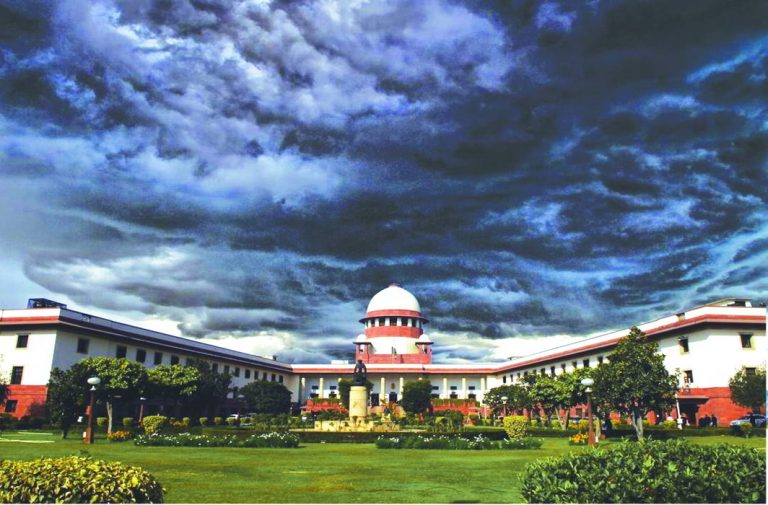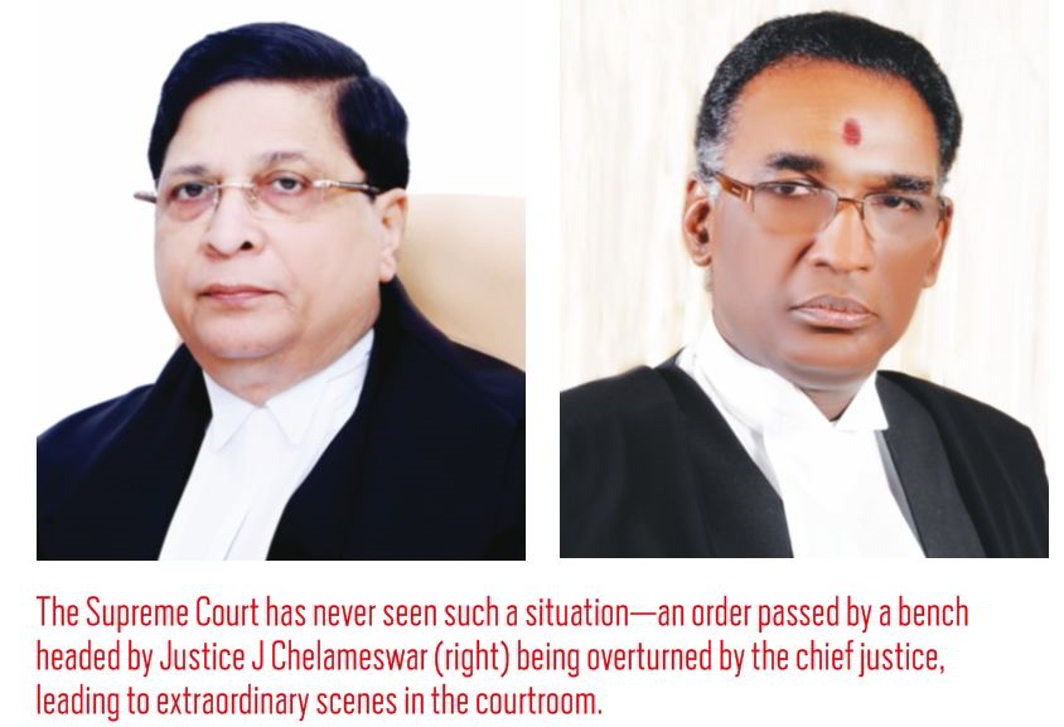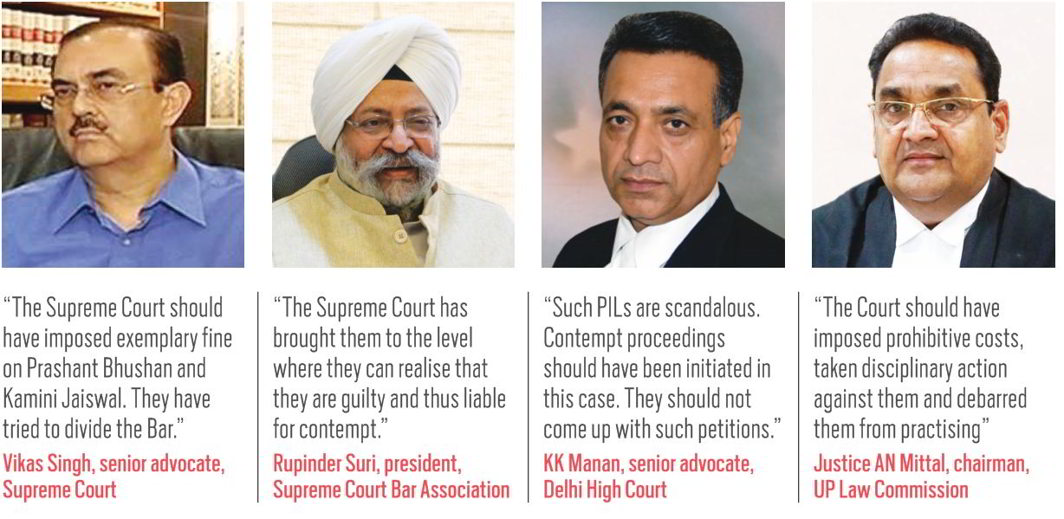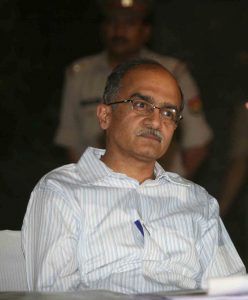
The storm in the Supreme Court following a series of extraordinary proceedings has abated but it has raised some important questions
~By Neeraj Mishra
“Though it is true, that none of us is above law; it is the duty of both the Bar and the Bench, to protect the dignity of the entire judicial system. We find that filing of such petitions and the zest with which it is pursued has brought the entire system in the last few days to unrest. An effort was made to create ripples in this Court; serious and unwanted shadow of doubt has been created for no good reason.”
—Supreme Court (November 14, 2017) in the matter of Kamini Jaiswal vs Union of India
Outside, a thick cloud of smog had enclosed Delhi in its unhealthy embrace all week. Inside court number 1 of the Supreme Court presided over by Chief Justice of India (CJI) Dipak Misra on November 9, another cloud was gathering. A bench was hearing advocates Indira Jaising and Rajeev Dhawan on behalf of the Delhi government on statehood status for the capital. At precisely 12:45 pm, the first warning signal was sounded when the seniormost judge in the Supreme Court after the CJI, Justice Jasti Chelameswar, on a petition by advocate Kamini Jaiswal decided to form a five-member constitution bench of the five seniormost judges of the Court. This was to deliberate on her demand for formation of an SIT to investigate the judiciary in the context of the arrest of retired Justice IM Quddusi in a bribery case.
The very next day, this judicial order became the cause of some extraordinary events. CJI Misra, who took up the hearing of the case himself, was furious at the insinuation that he had been dragged into a bribery case without being named anywhere in the FIR and his position and administrative powers as the CJI were being questioned. Advocate Prashant Bhushan, arguing on behalf of Jaiswal, was insistent that Justice Chelameswar was well within his rights to order the formation of a constitution bench. However, most senior members of the Bar say that Chelameswar had no authority to form such a bench which is the sole prerogative of the chief justice.
The war of words escalated with Attorney General KK Venugopal intervening in his official capacity and stating unequivocally that the case be thrown out as it was deliberately seeking to lower the dignity of the Court. The Supreme Court Bar Association (SCBA) then jumped into the fray and claimed that administration of the Court was the inalienable right of the CJI and he alone was the master of roster. Sundry other advocates present in the court, including the SCBA secretary, Gautam Bhatia, then gave their own opinions against the petitioners which led to Bhushan walking out of the Court after an altercation with the CJI.
Excerpts from the Court proceedings
November 10
Senior Advocate PS Narasimha is reading an order upon instruction of CJI Dipak Misra: It’s my discretion to decide whether a matter is to be taken up for constitution bench or not.
Prashant Bhushan: CJI should not be the member of this bench, he has corruption charges against him.
Justice Dipak Misra: You are not even worth contempt.
Justice RK Agrawal to Supreme Court Bar Association President: This is the duty of bar to take care of lawyers’ conduct. This court is not dutybound to look into lawyers’ conduct… Any FIR against any judge is not an FIR at all…
Justice RK Agrawal to Bhushan: Calm down sir…
Bhushan: I’m sorry to lose my temper. I don’t want to be heard in this extraordinary matter.
Justice RK Agrawal (in response to chaos in the court): Mr Bhushan has the right to speak. We are not inviting any condemnation.
Justice Misra: You can lose your temper and can have excuse for that. We judges can’t.
Justice Amitava Roy: You are abusing CJI on his face. He misbehaved with court in most atrocious and barbaric way.
Order of CJI: Chief Justice is the master of roster. On judicial side, he is first among equals. He alone has the prerogative to constitute a bench. This has been a convention of court because of laid law and because of judicial discipline and decorum.
November 13
Justice Arun Mishra: Why did you mention this petition on the second day, when the CJAR issue was taken up before the court? You are common advocate in both petitions. Why this multiplicity?
Prashant Bhushan: I got a call from the registry that the CJAR petition will be taken up by the other bench. On Thursday, Ms Kamini Jaiswal mentioned this matter. My only concern was that the assignment of benches should not take place by the judge, who is himself a part of these serious allegations.
Justice Arun Mishra: Why is your focus on court no. 2 (of Justice Chelameswar)? Why you are getting so particular about a bench? All the benches are same. What do you understand by the bench of five seniormost judges? We all are equal and gems of this institution. I have no grudges towards any of my companion judges. Even the CJI is equal to me. Mr Bhushan, because of your act, whole country is doubting the credibility of this institution. You can mention for early hearing, you can ask for early order.
But, as per your contention, we judges can’t formulate the bench as per judicial convenience.
Shanti Bhushan (father of Prashant) interjects: This matter should be referred to the constitution bench. This bench can’t have the confidence of a constitution bench.
Attorney General KK Venugopal: American courts have provisions of contempt for such kind of allegations.
Justice Arun Mishra: If such kind of allegations are to be considered in this manner, then no judges on earth will be spared. I admire Prashantji to file these petitions. The aim is to scandalise court no. 1. and get favourable part from court no. 2. To ensure the independence of the judiciary, the president shall accord the cases in which FIR is against the CJI. FIR allegations can’t be addressed in such a way.
AG: This petition should never have been filed.
Justice Arun Mishra: Not only was it filed, but re-filed and again filed.
AG: There are advocates who dupe clients. They assure clients that “I know this particular judge”.
Additional Solicitor General Tushar Mehta: The second petition didn’t even disclose the sub judice nature of this matter in some other petition. This is nothing but to scandalise the highly prestigious institution of judiciary.
Justice Arun Mishra: This petition has damaged the image of the most important judge, the CJI, of this court. Damages have been done to a great extent.
The CJI-led constitution bench then specified two important decisions: It reiterated the position of the CJI as the master of roster which effectively means no other judge can appropriate the case or cases from other courts to himself. It also reiterated that only the CJI could decide on the formation of a constitution bench and its constituents.
Nevertheless, a writ of mandamus was filed by senior advocate and former president of the SCBA Dushyant Dave on behalf of Kamini Jaiswal and some NGOs. The matter was then mentioned before the court of Justice Chelameswar (as the CJI was sitting for the constitution bench) with the plea that following the registration of the CBI case in the matter of Prasad Medical College in which involvement of members of the judiciary is alleged, an SIT be constituted by the Court to investigate the matter. It should be headed by a former SC judge. Justice Chelameswar listed the matter for hearing on November 10.
Controversial record
 Prashant Bhushan was at the centre of the events that roiled the Supreme Court. It raised questions that he, his father, Shanti Bhushan and Kamini Jaiswal, who were all involved in the court proceedings, are connected through organisations and common causes which can lead to conflicts of interest. Prashant has faced many charges earlier. They include:
Prashant Bhushan was at the centre of the events that roiled the Supreme Court. It raised questions that he, his father, Shanti Bhushan and Kamini Jaiswal, who were all involved in the court proceedings, are connected through organisations and common causes which can lead to conflicts of interest. Prashant has faced many charges earlier. They include:
FILING SUSPECT PILs: He was pulled up by the former Chief Justice of India TS Thakur for running a PIL centre. The court asked: “Why should we hear PILs filed by CPIL (Centre for Public Interest Litigation that Bhushan is associated with)? You are a professional litigant. Can you become a ‘center’ for PIL? …CPIL should not become proxy litigant. It should not become an instrument in the hands of commercial players.”
JAIN HAWALA CASE: This involved payments allegedly received by some leading politicians through the Jain brothers in the 90s. Journalist Vineet Narain responsible for the expose said: “I have burnt my fingers with the Bhushans… after initially helping me in drafting the petition (Jain Hawala case), the Bhushans made several attempts to sabotage the biggest crusade against corruption and finally derailed the case.”
HIMACHAL LAND SCANDALS: Prashant found himself entangled in land scandals in Himachal when he was found to have secured property by filing a false affidavit to ensure that he got domicile status (DS). Once he secured ownership, he sold the land only to purchase another property which was possible because he had domicile status. The case is currently being investigated by the state government. In February 2010, the BJP government in Himachal Pradesh permitted the Kumud Bhushan Educational Society, headed by Prashant, to buy tea-estate land at Kandwari near Palampur in Kangra district to set up an educational institution. The clearance was given when there was a ban on the sale of tea gardens in the state to non-agriculturists. The Congress government ordered a probe into the sale in March 2013 when it came to power which revealed: Permission was granted to purchase 122 kanal (15.25 acres) of tea estate land to start an educational institute within two years. However, no school or college came up. Instead, an institute called “Shambhawana” was set up, which conducted occasional seminars and workshops. It was not affiliated to any university or board. DIG AP Singh, head of the vigilance bureau, wrote to the state government that there was a violation of rules and the property should be confiscated.
STAMP DUTY EVASION: Prashant’s father, Shanti Bhushan, bought a house in the tony Civil Lines area of Allahabad for a paltry advance and then paid the remaining amount many years later. The property had been grossly undervalued during the sale. As a result, stamp duty of Rs 45,000 was paid for real estate worth about Rs 20 crore. The Assistant of Stamp Duty in Allahabad, Dr KP Pandey, said Bhushan has been found guilty of evading stamp duty and the property and related taxes had been grossly under-valued. Shanti Bhushan and his three children were slapped a notice and a fine for stamp duty evasion.
NOIDA FARM HOUSE: By declaring themselves as agriculturists by submitting a project report on the farming they intended to do, Shanti Bhushan and Prashant’s brother, Jayant, became owners of 10,000 sq m farmland plots in Noida. What was questioned was the manner in which the Mayawati government allotted the land to Bhushan senior and another plot of the same dimension to his son Jayant. There was also a question of conflict of interest, since Jayant appeared against Mayawati in the Noida Statue Park case.
CD CASE: An audio CD surfaced in 2011, in which Shanti Bhushan is allegedly heard claiming that son Prashant could fix any case for Rs 4 to 5 crore. He was purportedly speaking to a leading politician. Shanti Bhushan denied the conversation. Later, he agreed that he had met the politician and had telephoned him. Prashant and Shanti Bhushan claimed that the CD was doctored and submitted a private lab report supporting their assertion. However, the Delhi police confirmed the CD was genuine.
BURHAN WANI/PLEBISCITE CONTROVERSY: Prashant commented on the killing of Hizbul Mujahideen commander Burhan Wani, saying people suspected that Wani was killed in a fake encounter. This was the line being pushed by separatist groups in the valley. In September, 2011, Bhushan demanded a plebiscite in Kashmir and said that Kashmir should be allowed to break away from India if Kashmiris did not want to stay as part of India.
The CJI then allotted the matter to the court of Justice Sikri on the same date. On November 9, Dave and Bhushan came to know of the development and taking advantage of the Delhi statehood case proceedings in the CJI’s court, again mentioned a separate petition for urgent hearing before Justice Chelameswar through petitioner Jaiswal who is also a member of the CJAR. Justice Chelameswar subsequently ordered the formation of the five-member bench on November 13 which led to the furore.
On November 11, an extraordinary five-judge constitution bench was scheduled at 3.30 pm. The bench nullified the earlier order of Justices Chelameswar and Abdul Nazeer.
On November 13, a three-member bench formed by the CJI and headed by Justice Agrawal and comprising Justice Arun Mishra and Justice AM Khanwilkar dismissed the petition and raised the all-important question on why there was a need to file two petitions if it was not forum shopping, the byword for some lawyers looking for judges and courts they want. The Bhushans (see box) countered this, saying that Justice Chelameswar’s decision to form a five-member constitution bench of the five seniormost judges should be honoured as, under an interpretation of Article 144, he is entitled to. Justice Mishra then clarified in his order that not only is the CJI master of roster, he can do so even when an allegation has been made against him. He also reiterated that Article 144 is not attracted in this case.
Meanwhile, in the original petition of the CJAR, Justice Sikri on November 10 ordered that the matter be taken up by a five-member constitution bench to be decided by the CJI. The CJI has formed a three-member bench which will decide the case two weeks from now. The storm seems to have abated for now but it has left behind some unpleasant memories and an unnecessary reassertion of authority in the highest court of the land.

